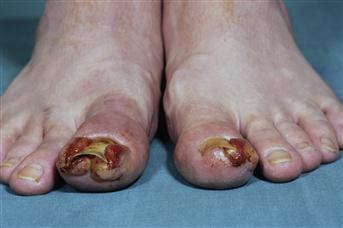Toe Lesions
Lesions of the toes are extremely common. They are caused by a variety of conditions ranging from simple ingrowing toenails to severe pain caused by ischaemia. Deformities of the toes are also exceptionally common, particularly in the elderly.
History
Nails
Ingrowing toenail usually presents with pain at the sides of the nail and often with infection and local inflammation. With infection, the toe is painful and throbs, especially in bed at night. With subungual haematoma, there is a history of injury to the nail. Bleeding occurs beneath the nail, which is extremely painful, and occasionally the patient may faint with the pain. Subungual melanoma presents with pigmentation under the nail. With subungual exostosis, there is lifting of the nail with deformity. Onychogryphosis is a ‘ram’s horn’ deformity of the nail. The nail thickens and curves over the end. It is common in the elderly but may occur in young people after injury to the nailbed.
Deformities
A patient with hallux valgus normally presents with a ‘bunion’. The first metatarsal deviates medially. It is more common in females. The patient may complain that the great toe overrides the second toe. Unsuitable, tight footwear may be a precipitating cause. Hallux rigidus is osteoarthritis of the first MTP joint. It occurs in young adults. The patient complains of pain on walking, especially when ‘pushing off’, and stiffness in the joint. Hammer toe usually affects the second toe. There is a fixed flexion deformity of the PIP joint and compensatory hyperextension of adjacent joints. The patient merely complains of a deformed toe, and may also complain of painful callosities that have developed where the deformed toe presses against the footwear. With clawed toes both IP joints are flexed. The tips of the toes may develop painful callosities.
Ulcers
Ulcers are usually ischaemic (painful) or neuropathic (painless). Check for a history of intermittent claudication, smoking, Raynaud’s disease, cardiac disease, diabetes. With neuropathic ulcers, there may be a history of diabetes, nerve injuries, spinal cord lesions. Ulcers usually occur on the pressure points over the tips of the toes. Neoplastic ulcers on the toes are extremely rare. Melanoma may occur on the toes but is usually subungual.
Discoloration
Painful discoloration, either red or shiny, white, blue or black (gangrene), suggests ischaemia. Chilblains occur in childhood and early adult life, usually in females. They are more likely in those with outdoor occupations. Painful swelling occurs on the toes, which may become itchy. They are often multiple and may develop into shallow ulcers.
Examination
Nails
With ingrowing toenails, there is often a serous discharge or purulent discharge from the nailfold. The toe becomes red and swollen. Granulation tissue may be apparent at the nailfold. Subungual haematoma is usually obvious. Occasionally however, the patient forgets the injury and presents with a brownish discoloration under the nail and this has to be distinguished from a melanoma. Haematoma is usually reddish-brown with sharp edges, the melanoma being brownish-grey with an indistinct edge. A haematoma grows out with the nail. A melanoma does not. With suspected melanoma, examine the regional lymph nodes and liver for secondaries. Subungual exostosis results in deformity of the nail, which is pushed up and deformed. The swelling between the toe and the end of the nail eventually becomes obvious. Onychogryphosis is obvious with a thick discoloured nail, which curves over at the end (ram’s horn deformity).
Deformities
With hallux valgus, the first metatarsal bone deviates medially, the great toe laterally. There may be a thickened bursa over the medial aspect of the joint (bunion). The great toe may override the second toe. In hallux rigidus, there is a stiff, painful, enlarged, first MTP joint. With hammer toe, the second toe is usually affected. There is a fixed flexed deformity of the PIP joint and compensatory hyperextension of the adjacent joint. Check for the presence of corns and callosities. In claw toes both IP joints are flexed (see Foot deformities, p. 160).
Ulcers
Punched out, painful ulcers over pressure points suggest ischaemic ulcers. Check for discoloration of the toe, capillary return and absence of foot pulses. Neuropathic ulcers are painless; the circulation is usually good, but sensation is absent or blunted locally. Carry out a full neurological examination.
Discoloration
With ischaemic toe, it may be shiny red, blue, white or black with gangrene. Examine the pulses. Chilblains are usually reddish-blue, the skin being oedematous and blistering may occur, which bursts, leaving superficial ulcers.





